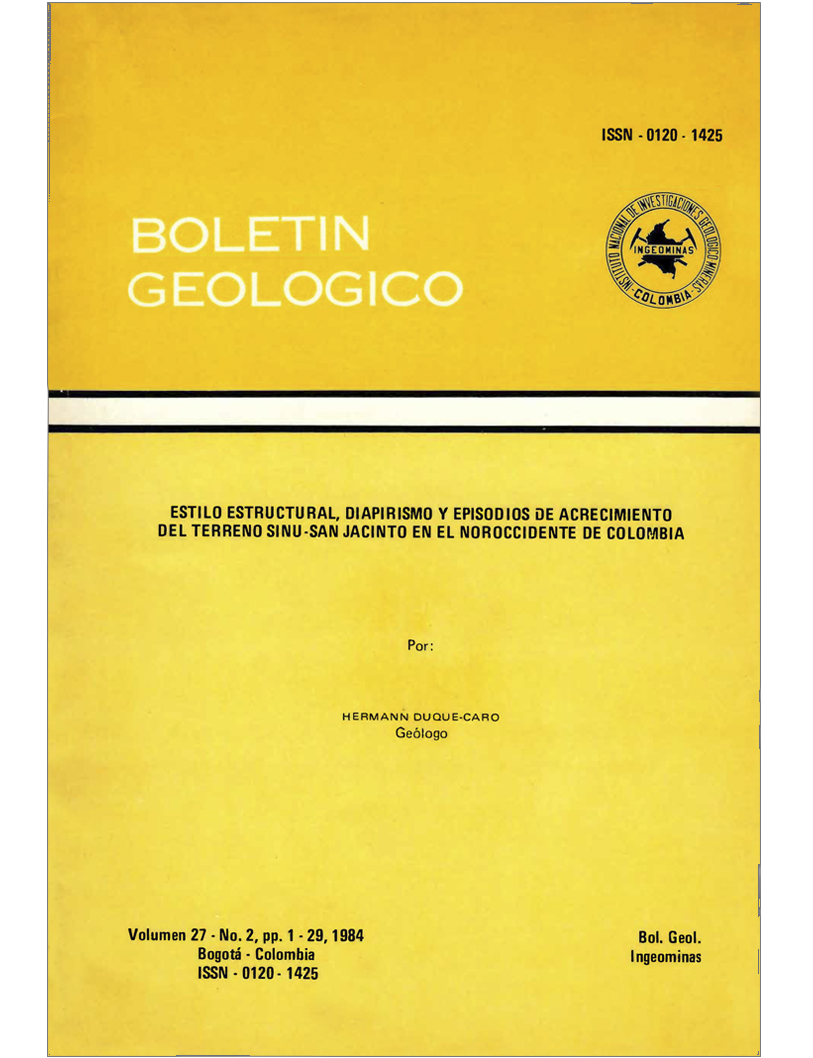Structural style, diapirism, and accretionary episodes of the Sinú-San Jacinto terrain in northwestern Colombia
DOI:
https://doi.org/10.32685/0120-1425/bolgeol27.2.1984.153Keywords:
tectonostratigraphy, deforming factor, pelagic, hemipelagic, orogeny, beltDownloads
How to Cite
Issue
Section
Published
Abstract
In this work, a review of the main structural and stratigraphic characteristics of the northwestern Colombian coast is made, which has led to the re-evaluation of previous interpretations. In this way, a new tectonostratigraphic province is defined: Sinú-San Jacinto terrain, where diapirism appears as the most important deforming factor.
Gravity weighting of turbiditic sediments on lower density pelagic and hemipelagic sediments generated diapirism along the marginal trenches during the two episodes of accretion of this terrain. The magnitude of deformation combined with uplift characterizes this diapirism as orogenic. The scales of deformation and uplift also appear directly related to the intensity of turbiditic sedimentation. Thus, the previously proposed compressional lateral stresses now appear as a minor factor in the internal deformation of this terrain.
The formation of this terrain occurred in two episodes that correspond to the formation of the San Jacinto and Sinú belts. The main diapiric events in the San Jacinto belt took place during the Paleocene to middle Eocene, and during the upper Eocene to lower Oligocene, and in the Sinú belt during the middle Miocene, and during the upper Miocene to Pliocene. Each episode of intense diapirism was followed by uplift with very little deformation. Diapirism always appears related to deep oceanic sedimentation, whereas uplift appears related to shallow marine sedimentation and terrestrial sedimentation. Two major unconformities have also been recognized in each diapiric event: middle Eocene and lower Oligocene for the San Jacinto belt and upper- middle Miocene and upper pre-Pliocene for the Sinú belt. Therefore, the previously proposed tectonic and sedimentary units are revised, and three new units are proposed: the Sinuense, the Turbacian, and the Sincelejian.
References
DUQUE-CARO, H., 1972.- Ciclos tectónicos y sedimentarios en el norte de Colombia y sus relaciones con la paleoecología: Bol. Geol. Ingeominas, Vol.19, No. 3, p. 1-23.
DUQUE-CARO, H., 1973.- The geology of the Montería area: Colombia Society of Petroleum Geologists and Geophysicists 14th Annual Field Conference, Guidebook, p. 397-431.
DUQUE-CARO, H., 1975.- Los foraminíferos planctónicos y el terciario de Colombia: Revista Española de Micropaleontología, Vol. 7, No. 3, p. 403-427.
DUQUE-CARO, H., 1979.- Major structural elements and evolution of northwestem-Colombia, in Watkins, J. S., and others, eds. Geological and geophysical investigationes of continental margin: American Association of Petroleum Geologists, Memoir 29, p. 329-351.
DUERAS, H., and DUQUE-CARO, H., 1981-. Geología del Cuadrángulo F-8: Bol. Geol. lngeominas, Vol. 24, No. 1, p. 1-35.
EDGAR, N. T., SAUNDERS, J. B., and others, 1973.- Site 154,. Initial Reports of the Deep Sea Drilling Project, Volume 15: Washington D.C., U.S. Government Printing Office, p. 407-471.
HAFFER, J., 1970.- Geological climatic history and zoogeographic significance of the Urabá region in northwestem Colombia; Caldasia, Vol. 10, No. 50, p. 603-636.
HOUTZ, R. E., and LUDWIG, W. J., 1977.Structure of Colombia Basin, Caribbean Sea, from profiler – sonobuoy measurements: Journal of Geophysical Research, Vol. 82, No. 30, p. 4861-4867.
KELLOGG, J. N., 1981.- The cenozoic basement tectonics of the Sierra de Perijá, Venezuela and Colombia (Ph. D. thesis): Princeton University, p. 230.
LU, R. S., and McMILLEN, K. J., 1982.Mulrichannel seismic suroey of the Colombia Basin and adjacent margins, in Watkins, J.S. and Drake, C. L., eds., Studies in continental margin geology: American Association of Petroleum Geologist, Memoir 34, p. 395-412.
MORGAN, J. P., 1961.- Mudlumps at the mouths of the Mississippi River, in Genesis and paleontology of the Mississippi River mudlumps: Louisiana Geological Survey Bulletin 35, Part I, p. 55-59.
MORGAN, J. P., and others, 1968.- Mudlumps: Diapiric structures in Mississippi delta sediments, in Braunstein, J., and o'Brien, G. D., eds., Diapirism and diapirs: American Association of Petroleum Geologists Memoir 8, p. 145-161.
O'BRIEN, G. D., 1968.- Suroey of diapirs and diapirism, in Braustein, J., and O'Brien, G. D., eds.; Diapirism and diapirs: American Association of Petroleum Geologists Memoir 8, p. 1-9.
PORTA, J., andSOLE de PORTA, N., 1960. El cuaternario marino de Tierrabomba: Bol. Geol., UIS, No. 4, p. 19-44.
PORTA, J., and others, 1963.- Nuevas aportaciones al Holoceno de Tierrabomba, Bol.Geol., UIS, No. 12, p. 35-44.
SHEPARD, F. P., 1973.- Seafloor of Magdalena delta and Santa Marta area, Colombia. - Geological Society of America, Vol. 84, p. 1955-1972.
STAINFORTH, R. M., 1968.- Mid-Tertiary diastrophism in northem South America, in Transactions, Caribbean Geological Conference, IV, Trinidad, 1965, p. 159-177, Caribbean Printers, A-rima, Trinidad.
VAN HOUTEN, F. B., 1976.- Late Cenozoic volcaniclastic deposits, Andean foredeep, Colombia: Geological Society of America Bulletin, Vol. 87; p. 481-495.










